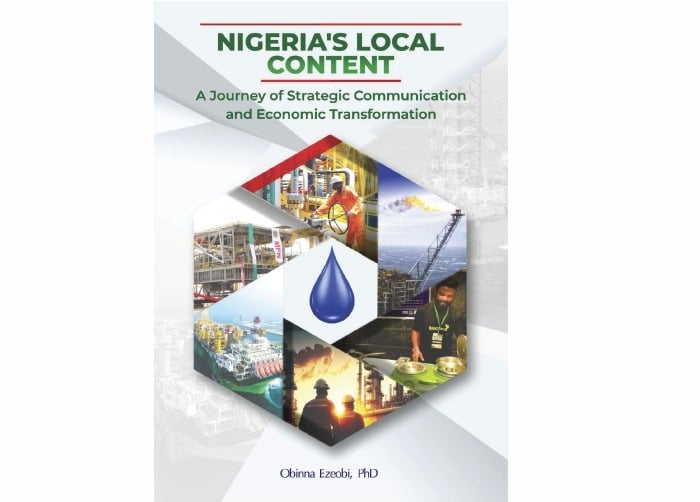BY CHIDO NWAKANMA
Dr. Obinna Ezeobi’s Nigeria’s Local Content: A Journey of Strategic Communication and Economic Transformation offers a compelling narrative on the evolution of Nigeria’s local content policy, emphasising the pivotal role of strategic communication and stakeholder collaboration. Published to coincide with the 15th anniversary of the Nigerian Oil and Gas Industry Content Development (NOGICD) Act, the book synthesises historical milestones, policy challenges, and lessons learned, establishing itself as a critical resource for policymakers, industry professionals, and scholars.
A distinguishing feature is its first-person perspective on a corporate narrative, as the author was involved for the 15 years the book covers. Even so, Ezeobi provides proper references from the best academic traditions.
The first Executive Secretary of the Nigerian Content Development and Monitoring Board (NCDMB), Dr. Ernest Chu Nwapa, provides context and motivation in the insightful foreword of the book. Communication professionals will applaud Nwapa’s argument for incorporating corporate communication from the project’s inception, as the industry has long advocated. Nwapa stated, “I will never forget the agony in those early days watching some top Nigerian managers of our Joint Venture (JV) partnerships and multinational companies presenting colourful models and scenarios designed in their home offices to discourage our local content drive while their expatriate bosses sat nodding in the audience. This dangerous strategy needed to be reined in by structuring Local Content communication across the industry. We required all companies to appoint Nigerian Content (NC) Managers who were responsible for aligning their companies’ messaging with the themes established by our team in NNPC.
Nwapa pronounces, “This book is authoritative with first-hand knowledge of the activities and philosophical underpinnings guiding the local content journey in Nigeria”.
Advertisement
Readers will discover many exciting details about the oil and gas industry. Numerous sections reveal the roles of strategic players and the behind-the-scenes activities. For instance, oil exploration began and continued for 21 years at Otuabagi instead of the commonly known Oloibiri. “Dainam Dakolo (2023) writes that Oloibiri used to be the traditional headquarters of the Ogbia nation, hence the name was adopted by the international oil company despite being a few kilometres away from the exact oil field.”
Author’s Expertise and Perspective
Ezeobi’s credibility stems from his dual expertise in energy communication and his frontline involvement in implementing Nigeria’s local content policy as a senior official at the Nigerian Content Development and Monitoring Board (NCDMB) since 2010. His media background—spanning journalism, public relations, and academia—enables a nuanced exploration of how communication strategies shape policy adoption and compliance. The book reflects his doctoral research in energy communication, blending academic rigour with practical insights.
Advertisement
Structure and Scope
The 267-page book is organised into five thematic sections, each addressing interconnected facets of local content development:
Historical Evolution: Traces the origins of Nigeria’s oil and gas industry and the NOGICD Act’s enactment in 2010, highlighting its role as a post-1999 democratic milestone.
Strategic Communication: Analyses campaigns, media engagement, and stakeholder dialogues that transformed local content into a national priority. Case studies, such as the 10-year strategic roadmap, illustrate how targeted messaging drove compliance.
Advertisement
Economic Impact: This report highlights job creation, SME growth, and technology transfer. These elements involve the creation of 50,000 direct jobs, the delivery of over 12 million training person-hours, and the local economy’s ability to retain more than US$8 billion from the average annual US$20 billion oil industry expenditure.
Contemporary Challenges: This section addresses oil company divestments, regulatory ambiguities (e.g., NITDA Guidelines), and infrastructure gaps such as power shortages.
Compliance and Enforcement: This section presents empirical data on how NCDMB’s communication strategies influenced corporate adherence to local content rules.
Strategic Communication as a Policy Catalyst
Advertisement
A central thesis is that communication and stakeholder engagement were instrumental in the NOGICD Act’s success. Ezeobi details how NCDMB used:
Narrative Building: Presenting local content as a vital economic factor for job creation and resource sovereignty, which resonates with both public and political stakeholders.
Advertisement
Multi-Stakeholder Collaboration: Partnerships with global tech firms, such as Microsoft and Cisco, and African organisations like the African Petroleum Producers Organisation (APPO) have expanded regional policy influence.
Crisis Management: Addressing backlash from international oil companies through dialogue and adaptive messaging.
Advertisement
Ezeobi argues that this approach offers a replicable model for other African nations, as APPO Secretary-General Dr. Omar Farouk Ibrahim endorsed. He cites and appraises local content examples from Ghana, Uganda, Kenya,
The author explores the link, similarities, and differences between local content and CSR. The notable difference is in intent and motivation.
While local content is a commercial imperative, CSR aims to build relationships that eventually yield commercial returns beyond goodwill. Indeed, goodwill now has a bookkeeping value.
Advertisement
Endorsements and Relevance
The book has garnered acclaim from Nigerian and African energy leaders, including: Heineken Lokpobiri (Minister of State for Petroleum Resources) and Ekperikpe Ekpo (Gas Minister), who praised its courage in documenting policy triumphs.
The foreword was authored by Dr. Ernest Nwapa (NCDMB’s pioneer Executive Secretary), who lauded its documentation of success stories.
Felix Omatsola Ogbe (NCDMB Executive Secretary) highlighted its aesthetic quality and pledged institutional adoption.
Its release aligns with Nigeria’s ambition to position itself as a regional tech and energy hub, leveraging insights from the oil sector to inform other economic policies.
Critiques and Opportunities
While the book excels in chronicling achievements, it could delve deeper into:
Policy Shortcomings: Limited critique of enforcement gaps, such as inconsistent regulatory compliance or corruption challenges.
Grassroots Perspectives: More voices from host communities and SMES would enrich the stakeholder analysis and strengthen the case for local content and CSR.
Future Roadmaps: Expanded discussion on adapting local content strategies to emerging sectors like renewable energy and AI.
Conclusion
Ezeobi’s work is a landmark contribution to understanding how strategic communication can drive economic transformation. Blending historical analysis, case studies, and empirical data offers actionable insights for policymakers and communicators alike. As Nigeria and Africa seek to harness natural resources for inclusive growth, this book serves as both a retrospective and a blueprint—a testament to the power of narrative in shaping national development.
Target Audience: Professionals in the oil and gas industry, communication specialists, policymakers, scholars, and historians interested in replicating Nigeria’s local content model.
Nigeria’s Local Content: A Journey of Strategic Communication and Economic Transformation is essential reading for anyone involved in resource-driven economies. It provides insights on policy advocacy, stakeholder management, and the intersection of communication and development.
Obinna Ezeobi (2025). Nigeria’s Local Content: A Journey of Strategic Communication and Economic Transformation. Lagos: Four Points Communications Limited. 267 pages. ISBN 978-978-776-523-4
First published in BusinessDay Newspaper.
Views expressed by contributors are strictly personal and not of TheCable.










